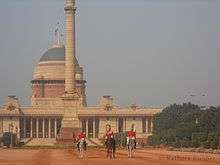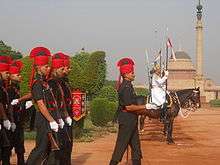President's Bodyguard
| President's Bodyguard राष्ठ्रपति अंगरक्षक | |
|---|---|
| Active | 1773 – present |
| Country | India |
| Allegiance | India |
| Branch | Indian Army |
| Type | Household cavalry |
| Role | Ceremonial during peace. Armoured reconnaissance & parachute pathfinders during war. |
| Size | 222 (4 officers, 20 JCOs & 198 soldiers)[1] |
| Motto(s) | भारत माता की जय Bharat Mata Ki Jai (Victory to Mother India)[1] |
| March | सारे जहान से अच्छा, हिन्दुस्तान हमारा Sare Jahan Se Achha, Hindustan Hamara[1] |
| Equipment | BTR-80 |
| Commanders | |
| Colonel of the regiment | Colonel Dhiraj Chengappa |
| Ceremonial chief | President of India |

The President's Bodyguard (PBG) (Hindi: राष्ट्रपति अंगरक्षक) is an elite household cavalry regiment of the Indian Army. It is senior-most in the order of precedence of the units of the Indian Army. The primary role of the President's Bodyguard is to escort and protect the President of India which is why the regiment is based in the Rashtrapati Bhavan in New Delhi, India. It is equipped as a mounted unit, with horses for ceremonies at the presidential palace and BTR-80 vehicles for use in combat. The personnel of the regiment are also trained as paratroopers and nominally are expected to lead in airborne assaults in the role of pathfinders. The regiment is the successor of the Governor General's Bodyguard of the British Raj.
History
The first bodyguard to be raised in India was in 1773 when European troops, already recruited into the East India Company's service as infantry, were earmarked for the role. Since the army of the East India Company had no cavalry of any kind at that point of time, two troops of dragoons and one troop of hussars were raised - the latter becoming the personal bodyguard of the Governor-General. These were however disbanded in the reorganisation of the army by Robert Clive after his return to India in 1765. By 1772, the Company did not have a single cavalryman in service.[2]
President's Bodyguard (PBG) is the oldest surviving mounted unit and the senior most regiment of the Indian Army. It was raised by Governor-General Warren Hastings in September 1773. Hastings handpicked 50 troopers from the Moghal Horse, a unit which was raised in 1760 by local sirdars. In the same year, the Raja Cheyt Singh of Benares provided another 50 troopers that took the strength of the unit to 100. The first commander of the unit was Captain Sweeny Toone, an officer of the East India Company, who had Lieutenant Samuel Black as his subaltern.
The establishment of the unit was as follows:
The Bodyguard was the only Corps of cavalry in the Bengal presidency until 1777 when two Regiments of Cavalry were transferred to the Company by the Nawab of Oudh. Both the regiments were raised in 1776.
Name
The name of the regiment has changed throughout its history:
| Year | Name |
|---|---|
| 1773 | Governor's Troop of Mughals |
| 1784 | Governor-General's Bodyguard |
| 1859 | Viceroy's Body Guard |
| 1944 | 44th Divisional Reconnaissance Squadron |
| 1946 | Governor-General's Bodyguard |
| 1950 | President's Bodyguard |
Strength and ethnic composition


Strength of the regiment varied throughout its history. Minimum strength of the unit was 50 when it was raised in 1773 but the precise maximum strength of the unit is not known. President of India's website claims a number of 1929 just before the First Sikh war but some historians believe the number to be 469. As per the book “Historical Records of the Governor General's Body Guards” published in 1910, maximum strength of the unit was 529 all ranks on 12 Feb 1844 just before the first Sikh War. In addition to 529 all ranks, orders were also issued to attach two Rissalahs of Irregular Cavalry, taking the strength of the unit to 730 all ranks. The present strength of the regiment is 4 officers, 20 junior commissioned officers and 198 sowars (cavalrymen).[1]
Ethnic composition of the unit also kept on changing. It started with Muslims (Moghals) from Awadh (Eastern U.P.) when it was raised in 1773. By 1800, Hindus (Rajput & Brahmins) were allowed to join GGBG along with Muslims but the area of the recruitment remained the same, Awadh & Bihar. In 1800, the recruitment pool was changed from Bengal Presidency to Madras Presidency & GGBG was reconstituted with troopers from Madras cavalry & for next 60 years, South Indian Castes formed bulk of the unit. After the Great Mutiny of 1857, center of recruitment of Indian Army was shifted from Awadh & south India to North India. GGBG was no exception & Sikhs were enlisted for the first time in Aug 1883 & Punjabi Muslims in Oct 1887. Recruitment of Brahmins & Rajputs ceased in 1895. After that, the recruitment was fixed at 50% Sikhs (Malwa & Majha) & 50% Muslims (Hindustani & Punjabi).
Currently Jat, Sikhs & Rajputs are taken in equal number,[1] primarily from the states of Punjab, Haryana & Rajasthan. Minimum height necessary to be enlisted is 6 feet.[1] Before independence the average height of the troopers was 6 feet 3 inches. Because of the personality & appearance of the men, popular acronym of GGBG was ‘God's Gift to Beautiful Girls'.


Battle honours
The President's Bodyguard has the following battle honours:[3]
- Java
- Ava
- Maharajpoor
- Moodkee
- Ferozeshah
- Aliwal
- Sobraon
all of which, except for "Java", are considered to be repugnant and cannot be carried on regimental colours.
Operational history
PBG first saw action in 1773-74 when it was deployed against Sanyasis – a band that ravaged the countryside in the guise of mendicants. Its next campaign was against Rohillas in April 1774 in the battle of St. George where Rohillas were defeated completely. The unit was also present during the 3rd Mysore War (1790–92) against Tipu Sultan. During this campaign, it successfully thwarted an assassination attempt on the life of Governor General Lord Cornwallis. In 1801, a detachment consisted of 1 Native officer & 26 other ranks went to Egypt to ride the horses of experimental horse artillery. It marched for 120 miles in the desert in the height of summer. All their horses died & they had to place the guns on camels. They never saw action in Egypt as Alexandria had capitulated by the time, they arrived there.
But all these campaigns did not bring any Battle Honour to GGBG. They earned their first Battle Honour ‘Java' in 1811 during the conquest of the island. At present PBG has the unique distinction of being the only surviving unit to carry this honour. In 1824, a detachment volunteered to sail over kaala paani (Black War, at that time, Hindu soldiers would refrain from sailing over sea for the fear of losing their caste) to take part in the first Burmese War and earned their second Battle Honour ‘Ava'. Body Guards received their third Battle Honour ‘Maharajpore' for the battle of Maharajpore in 1843 when British intervened in the battle for the succession that erupted in Gwalior after the death of Maharaja Scindia.
PBG fought all the main battles of the First Sikh War & earned four Battle honours. During the 1857 mutiny, Lord Canning himself asked the officers and other ranks to serve without arms as a precautionary measures, which they did in good faith and later, they escorted Lord Canning to the grand Darbar at Allahabad where on 1 Nov 1858, it was proclaimed that India will be governed by the Crown and title of Viceroy was conferred on the Governor General.
During the WW1, Lord Harding offered the Body Guards as Divisional Cavalry for the Meerut Division, which was going to France. But it was decided that the best use of the Body Guards would be working as trainers for raw remounts of cavalry & artillery. Thus for the entire period of the WW1, GGBG worked as remount training center. However, a detachment of the unit was sent to France as a reinforcement of 3rd Skinner's Horse. During the World War 2, for a brief period of time, GGBG served as 44th Division Reconnaissance Squadron.
Independence came with partition of the nation and armed forces were also divided in 2:1 ratio between India and Pakistan. GGBG was no exception, so Muslim elements of the unit went to Pakistan & Sikhs and Rajput elements stayed with India. The title of the Body Guard remained GGBG till 26 January 1950 when India became a republic & GGBG became President's Body Guard. The title remained GGBG in Pakistan until it became a republic 1956. The first commandant of the regiment was Lt. Col. Thakur Govind Singh and his adjutant was Sahabzada Yaqub Khan, who decided to join Pakistan Army. After the division of other assets of the regiment, when it came to gold plated buggy of the Viceroy, both India & Pakistan wanted it. To decide the fate of the buggy, Col. Singh & Sahabzada Yaqub Khan tossed a coin & India got the buggy.
The PBG has seen action in all of independent India's major wars. It rendered yeoman service in the capitol and helped reinstate confidence in the general public in the aftermath of the Partition. After Independence, Humbers and Daimler armoured cars formed the mounts of the PBG and were deployed in the defense of Chushul at heights above 14,000 ft during the 1962 Indo-China War.[4][5]
It participated in Operation Ablaze in 1965 indo-Pak war. The regiment served in Siachin glacier where it has been serving till date. A detachment of the regiment was a part of the Indian Peacekeeping Forces to Sri Lanka during 1988-89 & Indian contingents to UN Peace Keeping Forces to Somalia, Angola and Sierra Leone.
Other bodyguard units
Before Independence, there were three more body guard units, one for each Presidency. These units were called Governor's Body Guard (and not Governor General's Body Guards). All these units were disbanded in 1947.
Governor's Body Guard, Madras
This was the senior most regiment among the three Governor's Body Guard regiments. Raised in 1778 at Madras with one Sergeant, one Corporal & 12 European troopers & was placed under command of Lt. P. Sullivan. Unlike other Madras Army regiments, GBG, Madras retained its title throughout its history till 1947 when it was disbanded. The strength & composition of the unit, however, kept on changing. In 1778, it had one European troop & in 1781, the strength was raised to 1 European & 1 Native troops. The European troop was disbanded in 1784 & a company of the light infantry was attached. By 1799, strength of the GBG was raised to 100 men & they performed escort duty in Persia & Mysore war. From 1808 to 1820, detachments from different Madras cavalry regiments joined GBG on rotation.
The regiment took part in third Maratha War (1817–1819) where its charge along with 6th Bengal Light Cavalry changed the course of the war & considered as the decisive factor in winning the war. During the war, the regiment earned its only Battle Honour ‘Seetabuldee' for the relief of Nagpur Residency. GBG, Madras also took part in the First Burma war (1824–1826), where it rescued the advance guard which was surrounded by a large body of enemy force at Pagan. During the First World War, the regiment served as a remount training center and also patrolled the beaches during the bombardment of Madras by a German ship Emden. A combined force was also formed from detachment from Bombay & Madras Body Guards and was sent to serve in France.
The Governor's Body Guards, Madras also received a standard from Lord Willingdon in March 1924 bearing its only Battle Honour 'Seetabuldee'. At the time of its raising, the unit only had European troops. But 1781 onwards, South Indian classes dominated the regiment for most of the time, especially Deccani & Madrasi Muslims. In 1947, the unit had Rajputs from Rajasthan and Jats from Western UP and Punjab.
Governor's Body Guard, Bombay
The unit was raised on 22 March 1865 in Poona from a selected body of troopers of a disbanded unit, The Southern Mahratta Horse(SMH), which was first raised in 1850. Though the unit was re-organized twice in 1895 & 1938 there was no change in its title. It also retained its title throughout its existence until 1947, when it was disbanded. In 1865, it had Mahratta troopers only from SMH but later Sikhs, Deccani Muslims and Punjabi Muslims also served in the unit.
Governor's Body Guard, Bengal
In 1912, the capital of India was transferred from Calcutta to Delhi & the Viceroy, along with Governor General's Body Guard, moved to Delhi and Bengal got the status of the Presidency just like Bombay & Madras. At that time, Capt. Rivers Berney Worgan of 20th Deccan Horse raised Governor's BG, Bengal from volunteers from different Bengal cavalry regiments. This was the youngest unit among three GBG units. GBG, Bengal also retained its title throughout its existence & was also disbanded in 1947. Only Punjabi Muslims & Rajputs were recruited for the unit. Since GBG, Bengal came into existence in 1912, there is no photo of the unit by Fred Bremner.
When it came to uniform, all three GBG units followed the pattern of Governor General's Body Guards and they just added few articles like cummerbunds and plastrons.
Standards, guidons & banners

In 1779, the East India Company started issuing standards to Indian cavalry regiments. In 1800, GGBG was presented with its first Standard by Marquess Wellesley at the conclusion of his Review of the Body Guard. In 1815, the Countess of Moira & Loudon presented a standard to the newly raised squadron. Two more Standards were presented to the newly raised squadrons of the Body Guards in 1844, when the strength of the regiment was highest. Standards were abolished in regiments of Indian Cavalry in 1864 & in 1931, a Guidon was presented to the Body Guards, which was last carried on escorts in 1936.

Two Silver state Trumpets with Banners were presented to the Body Guards by Lord Reading in 1923 on the 150th anniversary of the raising of the unit. One banner represented Star of India with the battle honours of the regiment and the other banner carried the coat-of-arms of the viceroy. Each successive Viceroy presented a banner to the Body Guard on assuming office, banners of past viceroys being kept in the custody of the regiment. The practice is in place till date and every president present a silver trumpet to the regiment – the only difference being replacement of the coat-of-arms of the Viceroy with the monogram of the President.
First trumpet with banner by the President of Republic of India was presented by Dr Rajendra Prasad on 14 May 1957. It had maroon background, emblem and crest in gold thread. The design incorporated the initials of Rajendra Prasad in Devanagri script in the centre and four emblems in gold in all four corners of the banner, from the Personal Standard of the President. The Personal Standard of the Dr Rajendra Prasad was presented to the regiment on 18 Jan 1958 by the President himself. In Nov 1958, President Rajendra Prasad presented a new Regimental Standard to the PBG, the previous Regimental Standard had been laid up after India became a republic. The old regimental standard rests in the Regiment's Officer's mess.
When the second President of India, Sarvepalli Radhakrishnan assumed office, he presented his banner to the PBG on 21 Oct 1962. His banner had grey background and emblem and crest in gold thread. The design incorporated his initials in Devanagari script in the center and four emblems in gold in four corners, from the Personal flag of the President.The new President's Standard of the Body Guard and the Regimental Standard were awarded by the President Radhakrishnan on 11 Nov 1963. The Regimental Standard is dark blue in colour with Regimental crest in the centre surrounded by the lotus flowers and Ashoka leaves. Five scrolls on either side of the crest are for the Battle Honours and the standard bears the motto “Bharat Mata ki Jai”.
Present status
In 2003, the President's Bodyguard had an establishment of 7 officers, 15 NCOs, and 140 enlisted men, for a total strength of 180 men. Throughout its history, the Bodyguard has varied in size from 50 men when first raised, to 1929 men in 1845. However, it was usually around squadron size, or about 130 men.
By tradition, the CO has always been of Brigadier or Colonel rank. He is assisted by Majors, Captains, Risaldars and Daffadars.Soldiers hold the ranks of Sowar or Naik. Recruitment to the Regiment in India now is in equal share, to Jat Sikhs, Hindu Jats and Rajputs, with officers and administrative staff from all over India.
References
- 1 2 3 4 5 6 Nath, Ashok (2009). Izzat: historical records and iconography of Indian cavalry regiments, 1750-2007. Centre for Armed Forces Historical Research, United Service Institution of India. pp. 542–543. ISBN 978-81-902097-7-9.
- ↑ Jackson, Major Donovan (1940). India's Army. London: Low, Marston. pp. 1–8.
- ↑ Singh, Sarbans. Battle Honours of the Indian Army 1757 - 1971. New Delhi: Vision Books. ISBN 81-7094-115-6.
- ↑ "The President's Bodyguard". The President of India. The President's Secretariat, Government of India. Retrieved 29 March 2014. External link in
|work=(help) - ↑ Bhat, Anil (2011). "A Tryst with India's History". Salute magazine. Archived from the original on 23 Mar 2014. Retrieved 29 March 2014. External link in
|work=(help)
External links
| Wikimedia Commons has media related to President's Bodyguard. |